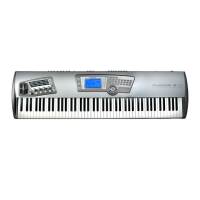ALESIS FUSION
ANALOG SYNTHESIS TUTORIAL
SOUND PROCESSORS / MODIFIERS
Filters
If the oscillators are the ‘strings’ of an analog synthesiser,
the filter is the heart and a synth can
stand or fall on the quality of its filter(s).
Put simply, the filter is one big, drastic tone control that
can modify the basic sound generated
by the oscillators. We learned about harmonics in the first section of this tutorial
- the filter’s job
is to selectively filter out (or sometimes
enhance) these harmonics, thus changing the tone or
‘timbre’ of the sound.
There are many types of filters
around that perform different jobs... or rather, have a different
effect on the raw sound they are processing. The most common filters are:
Lowpass filter
Allows low frequency
harmonics to pass through unaffected, removing higher frequency
harmonics above the cutoff frequency:
In this example,
you can see that all harmonics above the 6th harmonic are ‘cut off’ or filtered
out. This is the most common filter found on ALL analog
synthesisers. It closely replicates
nature in
that higher frequencies tend to have less energy and so dissipate and die away
quicker than lower frequencies (which is why decaying
instruments such as guitar, piano, etc.,
become softer or ‘duller’ as the note dies
away). It is also a natural phenomenon that if an
instrument is played (i.e. plucked, bowed, hit, blown - whatever) harder, more high frequency
harmonics are ‘agitated’ and so the sound is brighter (and
vice versa
-
if an instrument is played
more softly, it sounds more ‘muted’). We can use the
lowpass filter to mimic these (even if the
sound is overtly ‘synthy’!).
Bandpass filter
Allows a band of harmonics to pass through
but removes harmonics either side (below and
above) that band:
From the diagram above,
you can see clearly the effect it will have on the sound - the
fundamental is attenuated and harmonics above the
8th are filtered out. As a result, lacking a
strong fundamental frequency, the sound is going to be a bit weak and comprising only middle
frequency harmonics, can sound bright and ‘fizzy’. That’s
not to say this filter is not without its
uses
- it’s a popular filter in many dance/trance/techno genres for creating bright, ‘fizzy’
leadlines and chordal stabs in anthemic ‘Ibiza’ dance music.
Sound processors / modifiers
Page
10

